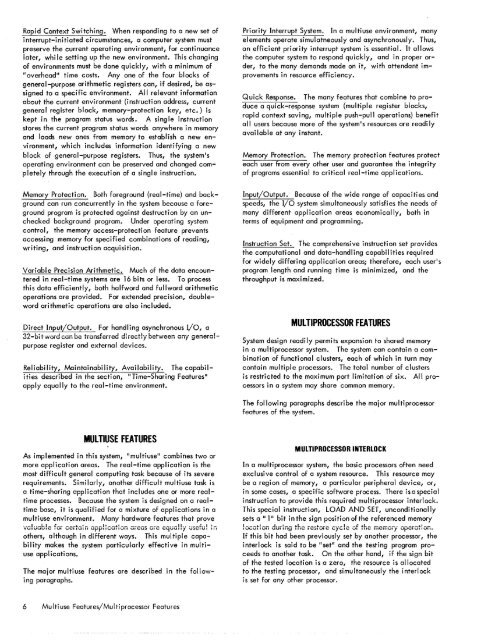1. xerox 560 computer system - The UK Mirror Service
1. xerox 560 computer system - The UK Mirror Service
1. xerox 560 computer system - The UK Mirror Service
You also want an ePaper? Increase the reach of your titles
YUMPU automatically turns print PDFs into web optimized ePapers that Google loves.
Rapid Context Switching. When responding to a new set ofinterrupt-initiated circumstances, a <strong>computer</strong> <strong>system</strong> mustpreserve the current operating environment, for continuancelater, whi Ie setting up the new environment. This changingof environments must be done quickly, with a minimum ofII overhead ll time costs. Anyone of the four blocks ofgeneral-purpose arithmetic registers can, if desired, be assignedto a specific environment. All relevant informationabout the current environment (instruction address, currentgeneral register block, memory-protection key, etc.) iskept in the program status words. A single instructionstores the current program status words anywhere in memoryand loads new ones from memory to establish a new environment,which includes information identifying a newblock of general-purpose registers. Thus, the <strong>system</strong>'soperating environment can be preserved and changed completelythrough the execution of a single instruction.Priority Interrupt System. In a multiuse environment, manyelements operate simulatneously and asynchronously. Thus,an efficient priority interrupt <strong>system</strong> is essential. It allowsthe <strong>computer</strong> <strong>system</strong> to respond quickly, and in proper order,to the many demands made on it, with attendant improvementsin resource efficiency.Quick Response. <strong>The</strong> many features that combine to producea quick-response <strong>system</strong> (multiple register blocks,rapid context saving, multiple push-pull operations) benefitall users because more of the <strong>system</strong>'s resources are readi Iyavai lable at any instant.Memory Protection. <strong>The</strong> memory protection features protecteach user from every other user and guarantee the integrityof programs essential to critical real-time applications.Memory Protection. Both foreground (real-time) and backgroundcan run concurrently in the <strong>system</strong> because a foregroundprogram is protected against destruction by an uncheckedbackground program. Under operating <strong>system</strong>control, the memory access-protection feature preventsaccessing memory for specified combinations of reading,writing, and instruction acquisition.Variable Precision Arithmetic. Much of the data encounteredin real-time <strong>system</strong>s are 16 bits or less. To processthis data efficiently, both halfword and fullword arithmeticoperations are provided. For extended precision, doublewordarithmetic operations are also included.Direct Input/Output. For handling asynchronous I/O, a32-bitword can be transferred direct!y between any genera!purpose register and external devices.Reliability, Maintainability, Availability. <strong>The</strong> capabilitiesdescribed in the section, II Time-Sharing Features llapply equally to the real-time environment.Input/Output. Because of the wide range of capacities andspeeds, the I/O <strong>system</strong> simultaneously satisfies the needs ofmany different application areas economically, both interms of equipment and programming.Instruction Set. <strong>The</strong> comprehensive instruction set providesthe computational and data-handling capabilities requiredfor widely differing application areasi therefore, each user'sprogram length and running time is minimized, and thethroughput is maximized.MULTIPROCESSOR FEATURESSystem design readily permits expansion to shared memoryin a multiprocessor <strong>system</strong>. <strong>The</strong> <strong>system</strong> can contain a combinationof functional clusters, each of which in turn maycontain multiple processors. <strong>The</strong> total number of clustersis restricted to the maximum port limitation of six. All processorsina <strong>system</strong> may share common memory.<strong>The</strong> following paragraphs describe the major multiprocessorfeatures of the <strong>system</strong>,MULTIUSE FEATURESAs implemented in this <strong>system</strong>, IImultiuse ll combines two ormore application areas. <strong>The</strong> real-time application is themost difficult general computing task because of its severerequirements. Similarly, another difficult multiuse task isa time-sharing application that includes one or more realtimeprocesses. Because the <strong>system</strong> is designed on a realtimebase, it is qualified for a mixture of applications in amultiuse environment. Many hardware features that provevaluable for Certain application areas are equally USeful inothers, although in different ways. This multiple capabilitymakes the <strong>system</strong> particularly effective in multiuseapplications.<strong>The</strong> major multiuse features are described in the following paragraphs.MULTIPROCESSOR INTERLOCKIn a multiprocessor <strong>system</strong>, the basic processors often needexclusive control of a <strong>system</strong> resource. This resource maybe a region of memory, a particular peripheral device, or,in some cases, a specific software process. <strong>The</strong>re isa specialinstruction to provide this required multiprocessor interlock.This special instruction, LOAD AND SET, unconditionallysets a 11111 bit inthe sign position of the referenced memorylocation during the restore cycle of the memory operation.If this bit had been previously set by another processor, theinterlock is said to be IIset" and the testing program proceedsto another task. On the other hand, if the sign bitof the tested location is a zero, the resource is allocatedto the testing processor, and simultaneously the interlockis set for any other processor.6 Multiuse Features/Multiprocessor Features
















